Hi Everyone!
Another weekend has passed, and therefore some more sourdough experimentation has taken place.
For reference, this is a followup to this post about my very first sourdough bake a little over a week ago.
I believe this weekend's experiments have reinforced the idea that my starter is not quite "taking care of business", but I figured I would upload a few photos and see what the experts think.
So, consensus on my first bake was that my biggest issue was underfermentation, and given that I bulk fermented for something like 8-9 hours with 20% starter (which I gather should be more of a 4-6 hour affair, depending on temp and other factors), I translated this into an assumption that the management of my starter itself was my biggest issue.
This weekend I tried doing two loaves in parallel, one with a 1-5-5 levain and one with a 1-3-3 (I used 1-3-3 on my first bake)--not sure I'm using the term levain properly, but basically I created two separate "offshoots" from my starter the evening before my bake. Other than the ratios of the starters, everything else about my method was (virtually) identical...I say virtually, because of course one dough would be folded a couple of minutes after the other one, etc, but I figure these little differences in the grand scheme of things should be close to negligible.
Recipe (of each individual dough/loaf):
- 500g Unbleached White AP flour (robin hood)
- 330g Water
- 10g salt
- 100g starter
Method (to keep this from getting too long, I've left out some steps like folding etc...if those could be huge factors let me know and I'll elaborate...I think the point is I did the same thing on both)
My kitchen floats between 21 and 22 degrees C
- Mix both levains @ 9:30pm night before (both are 100% hydration, Robin Hood WW Flour)
- Next morning, mix AP flour and water, autolyse 1 hour
- Add starter, salt (this occurs at 10am, a little over 12 hours since since levains created)
- Once doughs are incorporated and have come together a bit (via a bit of folding), make an aliquot (note I only did one--from the dough based on the 1/5/5 levain--figuring proceeding with both loaves when that was ready would provide a good side-by-side comparison...in hindsight I wish I'd done both)
- Bulk ferment (with occasional folds) until aliquot doubles.
- Aliquot doubled by 7pm (9 hours!) -- it had barely moved as of about 5pm, but then accelerated from there
- Shaped both loaves, and put in fridge to proof overnight (bannetons in plastic bags)
- Out of fridge at 10am the next day--incidentally, I put the aliquot in the fridge too, and there was no visible additional rise
- I think they both passed the post-proof poke test, but honestly I'm not experienced enough yet to know for sure
- Baked at 450F on stone with steam for 20 minutes, then without steam for an additional 20
I've added some pics at the bottom of this post for inspection. Although the loaves look pretty different, I think they both still meet the criteria for being underfermented that were laid out in last week's comments. I was expecting the 1/5/5 to be the more successful of the two, as 1/3/3 had already "failed" the previous weekend, but honestly looking at the two of them I'm not sure which came out stranger. The giant burst at the bottom of the 1/5/5 loaf is particularly interesting/confusing (both loaves we scored on top--more-or-less as identically as my rookie hands are capable of).
So I think this additional set of underfermented bakes reinforces the theory that there's something wrong with my starter. I believe I'm prepping it in a way that should work, but I'll try to summarize quickly in case I'm doing something particularly boneheaded:
- The starter is roughly 2 weeks old. For the first week, I fed once a day at 8pm. By the time I went to re-feed, it would usually be quite sour-smelling, with a bit of liquid beginning to form on top (I gather this is an indicator that it's run out of food).
- For the more recent 7 days I have been feeding twice a day (8am and 8pm). 25g starter / 75g WW flour / 75g water. Now the starter is usually bubbly and active looking at feeding time. I would say on average it's usually sitting roughly a little over doubled in size (but nowhere near tripled)
- I prepped the two levains the night before the bake as
- 25g starter/75g water /75g flour
- 20g started/100g water/100g flour
- Just prior to adding to the doughs the following morning, the levains were (again) a little more than doubled in size, both of them looking bubbly and active. To my untrained eye, there were not many visible differences between the two.
So two main things on on my mind:
- In last week's thread, somebody mentioned their starter and/or levain growing 3.5x or even 5x. I have never seen my starter do anything even approaching this...does this mean I'm doing something wrong in the prep or maintenance?
- The only other theory I have: I recall seeing in one of the many starter guides I've consumed, somebody saying that if you change the kind of flour you're feeding a starter, it may take a while for the yeast/bacteria to "get used to it" and that this can result in your starter seemingly going dormant for a bit...I have no idea how true this is, but it could be a possible explanation...I've fed my started exclusively WW flour, and then I'm asking it to ferment a dough that's made with AP...is my yeast confused and not eating as a result? Should I start feeding my starter AP for a while and see if that helps?
Ok, holy cow that was long. If you got this far, thanks for taking the time. Here are the Pics:
Both loaves as they came out of the oven (the 1/3/3 is further from the camera, the 1/5/5 closer):
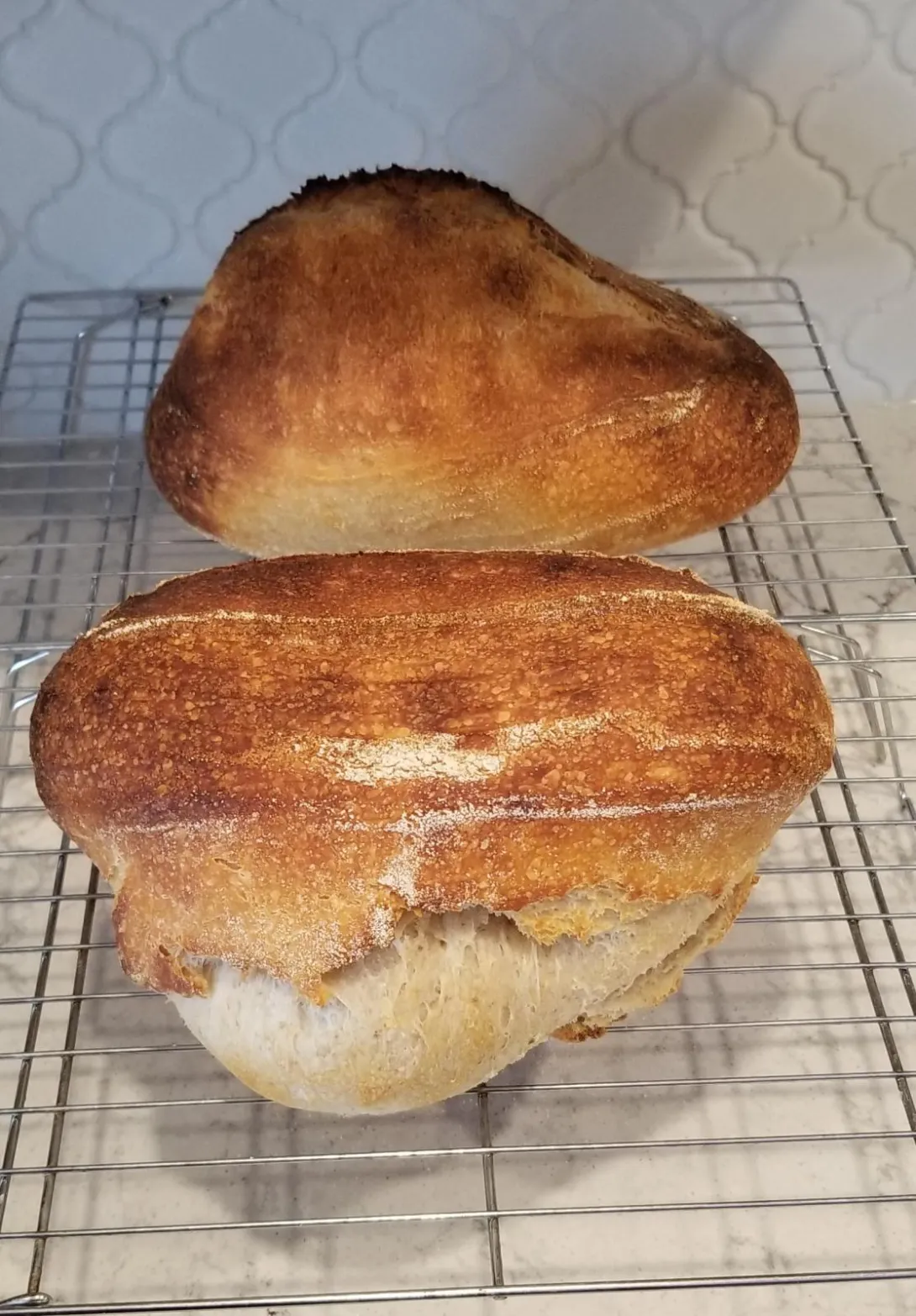
The 1/3/3-based loaf (loaf, crumb, crumb closeup)
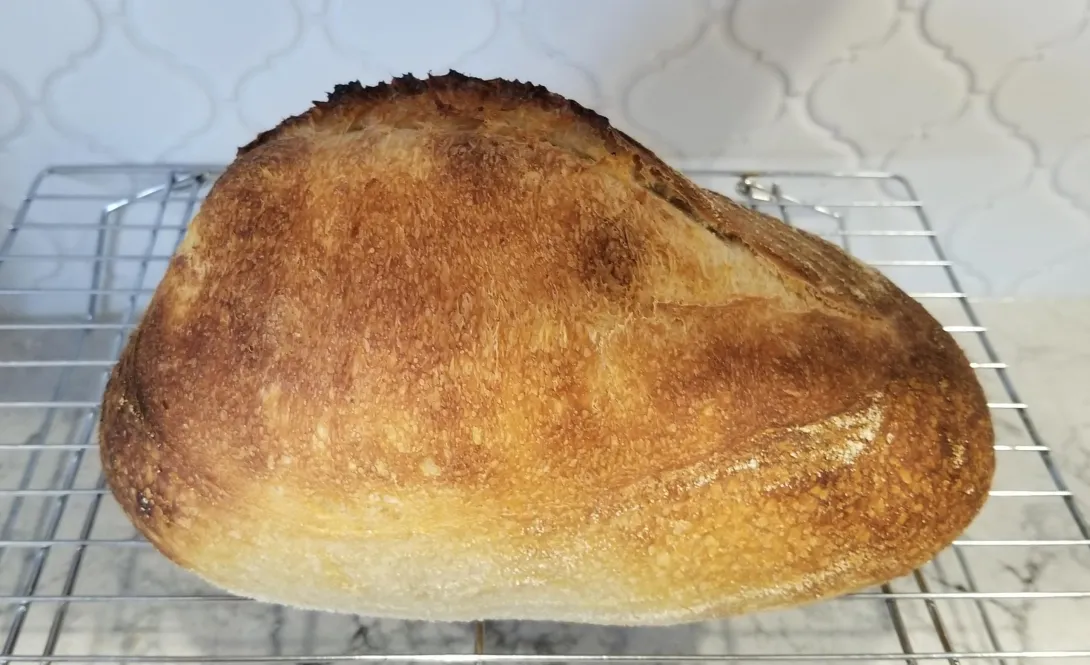
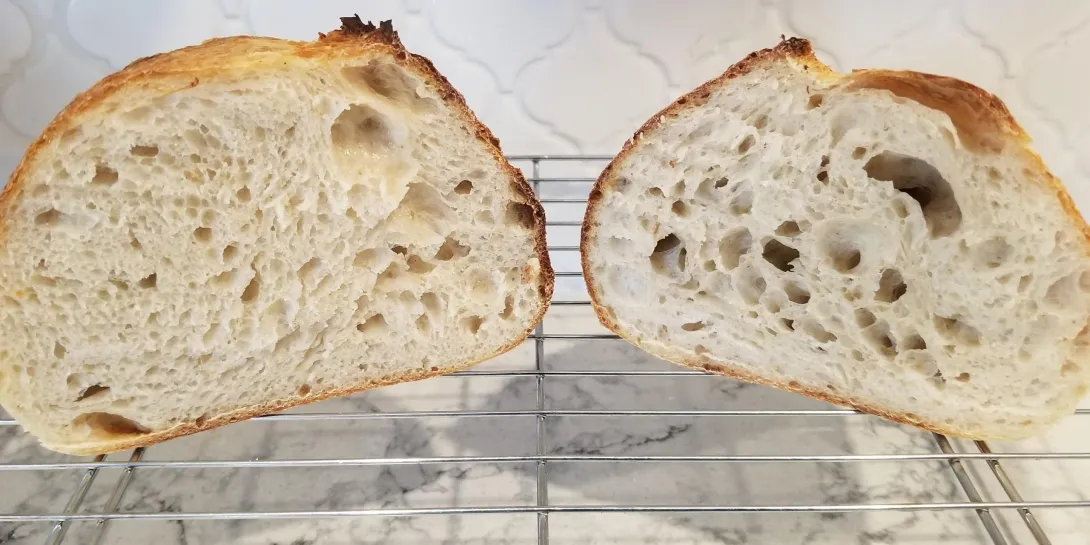
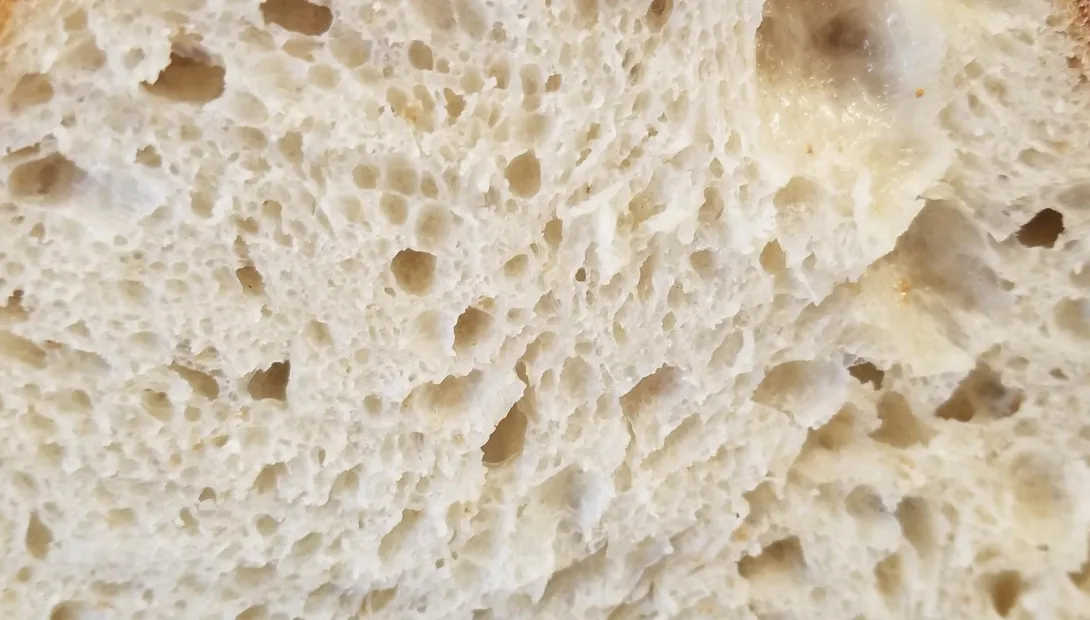
The 1/5/5-based loaf:
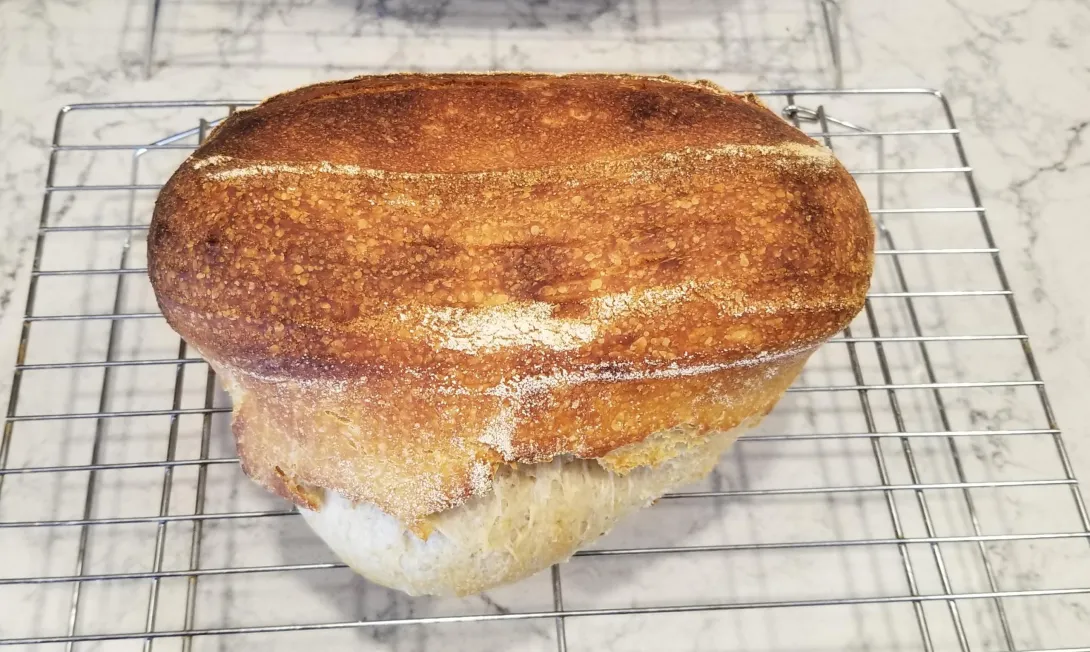
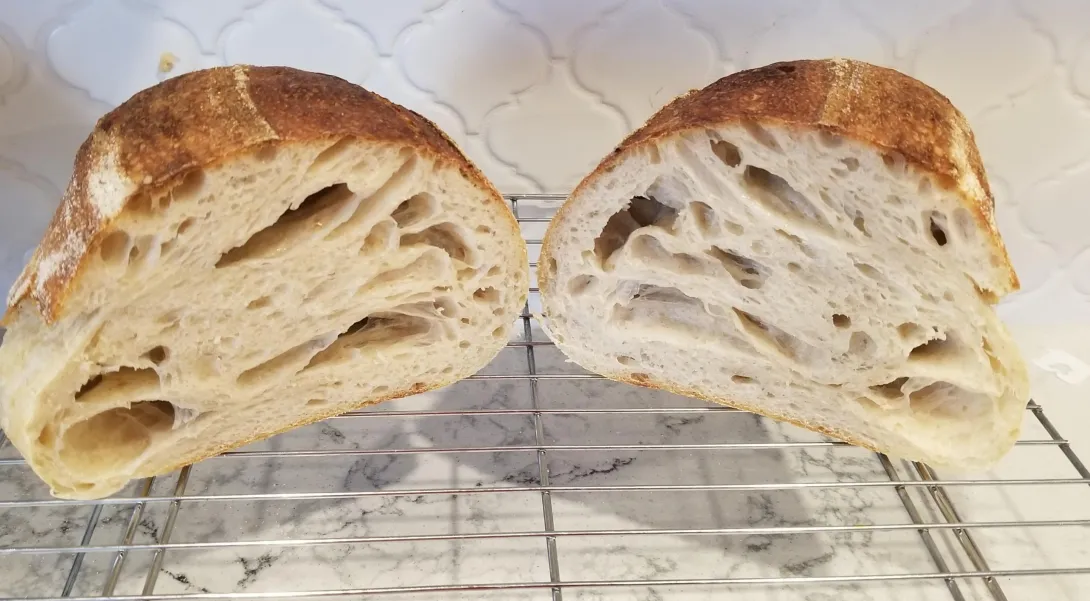
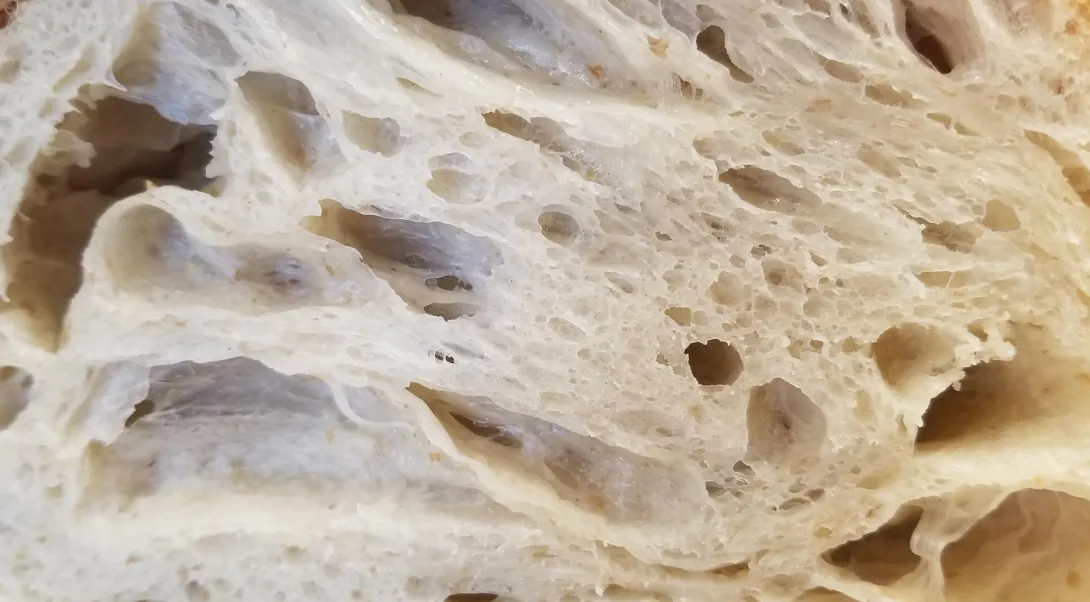
Is the better of the two and better than last week. I think it looks very good indeed. Some indicators your starter is "slow" - then again all starters are different - but I think that's a lovely bake. Your well explained and in-depth write up has told us something. Yes, your starter is slow but the 1:3:3 levain build (yes, an off-shoot starter build is a levain) had a better outcome than the 1:5:5 levain build because it had a smaller feed and matured more so in that time frame. So now you're building a picture of your starter...
1: It is a slow starter which could just be the nature of it. You'll fare better with really long ferments. Some people have the opposite 'problem'.
2: 12 hours at 21-22°C the 1:3:3 build did better than the 1:5:5 build. So either keep the feed at a low ratio when 21-22°C for 12 hours. Or increase the temperature if using a higher feed of 1:5:5 and see how it reacts. Recommended temperature of 25.5°C (78°F).
Keep this up! You're getting to know your starter and the sourdough process. A few more pieces of the jigsaw just fell into place.
I appreciate the encouragement, as well as the insight as always.
I'm starting to formulate next week's experiments already...I think I may try to do a bunch of 1:3:3 levains all built at different times to see if I can find the sweet spot (i.e. start the dough at something like 8 / 12 / 16 hours into the levains life and see how the results differ)...and this time I'll definitely do aliquots for every dough so I can track the rise a bit more scientifically (I let the lack of identical tiny containers stop me this time, but I'll figure out a solution for the next one!)
For sure the thing I'm finding the most challenging right now is "reading" my starter. I've consumed all kinds of content about how to identify the perfect time to use your starter, like watching for when the peak has just fallen or is just about to fall, or watching out for the aroma transitioning from bananas to something more sour, and all manner of other indicators, but I think like you're saying it's really just going to come with first hand experience with my own starter (because none of that stuff is objective enough for me to be sure that I'm interpreting or applying it correctly).
Thanks again for your help. I'm thinking between now and next weekend, I may make the transition to a Blog so I'm not monopolizing the forums with all of these magna cartas.
For both loaves I proofed overnight in the fridge. I've been baking yeasted loaves for a couple of months now, but I always do those same-day, so I don't have a lot of experience using the fridge (and even if I did, I'm not sure it would translate to sourdough anyway).
I realize there are a lot of variables, but in general is an overnight proof in the fridge sufficient on its own (i.e. straight in after shaping and then straight out into the oven), or should I be doing an hour or two at room temp first (and/or pulling it out of the fridge in advance of baking)?
I know the fridge slows the action waaaaaayyyy down, but I've never been entirely clear on how much, and I figure the dough doesn't instantly drop to fridge temp either, so it probably does a decent amount of proofing right after I put it in....etc.
I know... Very helpful!
Proofing in the fridge is a bit of trial and error. It depends a lot on how strong your starter is, how much starter is used and how far along the bulk has gone. And also how cold your fridge is.
I'm thinking your starter is telling you that if final proofing in the fridge you should have a high percentage of starter and a well done bulk ferment.
For some a 1:3:3 will be sufficient at 8 hours for the starter build and 20% starter/levain will be sufficient at about 4 hours bulk ferment for an overnight final proofing in the fridge. Others might find that it doesn't come out ready, be it their starters are slower or because their fridges are colder, so either they give it some bench time after shaping and before refrigerating or they give it some bench time after refrigeration.
I figured that would probably be the answer, but I appreciate the rule-of-thumb info to use as a basis for my own testing! Based on how slowly everything is going in general for me, I'll probably do a bit of bench proofing on the next round just to be safe. I have very little confidence in my ability to read the "poke test" currently, so am flying more or less blind. One more variable to fiddle with I suppose.
"One more variable to fiddle with I suppose".
You'll figure that one out then another will crop up and so on. Every time you try something new. But it's never back to the drawing board rather just a better understanding of your starter and new techniques. However long one has been baking there's always something new to learn.
It's only been a couple of short months for me (and even less for sourdough specifically), and I'm already loving that element of this hobby. Always something new to learn; always improvements to be made!
Your 1:3:3 starter build and technique, including refrigeration, looks excellent. Use that as a base to build upon. Such a lovely inviting crumb. The blowout I would think is down to the actual baking. Other then that i'd be well happy with that bake.
I really do appreciate it. And I agree, I think I've got something resembling a good "baseline" from which I can conduct little experiments.
Even this weekend's 1:3:3, which I agree is a nice improvement on last week, got feedback from the other consumers that it seemed "undercooked". I think I've learned from my various threads on this site that what laypeople interpret as undercooked is more likely underfermented (particularly given that the internal temp is above target when coming out of the oven). So even though my timelines already seem pretty long, I may push it even further next time and see if I can get the crumb a little....fluffier? I don't know...there are so many descriptors flying around, and I'm not confident I know what any of them mean haha.
Anyway, thanks again...I'm really enjoying myself!
Is not under fermented. Last week's was but this one has a nice even crumb. False crumbs are under fermented and this is not a false crumb. Perhaps a tad under proofed (there is a difference) and probably the bake itself but the crumb is good.
Ok, in that case I won't push it any harder :)...maybe a little bit of non-fridge proofing like we talked about before, but otherwise I'll leave that variable alone for now.
Your loaves look great for your novice status. Significantly better than my early loaves.
As to your theory that the starter is fed WW and therefore doesn’t want to ferment AP flour, I don’t think so. I feed my starter a revolving door of AP, Rye, Pumpernickel, and WW (sparingly, but it’s happened). My starter consistently doubles or triples in size. The combination of flours, over the long term, give the starter great complexity of flavor, in my opinion.
my point is that you just need a lively starter. The best thing yo can do at this point, IMHO, is to continue to feed it a few times a day until it is consistently doubling or tripling in size in twelve hours.
frank